Recovery Program.
Posted on | July 17, 2012 | 1 Comment
The dry spell passed last week and we finally got some rain. Not that people around us hadn’t been getting rain. They did. They always do. We often sit on the deck listening to the deafening thunderclaps and watching the lightning flashing over the towns next door. But we are dry as bone.
That’s because one of the neighboring towns does not have a mountain. So it gets all the rain that comes from the west. Or the south. I’m never really sure which direction the weather is coming from because the highway going to that town tells me I am on I-40 West but also I-85 South. I realize the DOT labels a highway as going “West” if it primarily goes west and “South” if it primarily goes south. I’m not sure how they get away with that. If I claimed that I obeyed the speed limit because I was primarily going 65MPH, I don’t think the Highway Patrol would agree with me. I mean, what if I got pulled over and said, “Hey, mister, if you can say you were driving west on a southbound highway, then I can say I was only going 65.”
That’s totally hypothetical. I would never actually say that. Because I primarily don’t want to go to jail.
So, due to all this confusion, I like to think that the weather comes from the left. ‘Cause that’s where it comes from when I am sitting on the deck, hoping for rain. And that makes it so much clearer. To me.
But the storms and the rains never actually make it to my little plot of shriveling cucumber vines and wilting pepper plants.
That’s because the town to the north east right of us does have a mountain. Not a snow capped, mountain goat kind of mountain. An elevation of 867 feet kind of mountain. Which makes it just high enough to be an easy hike with the kids and the dogs, but still a whole lot more fun to hike down. It also makes it high enough that it sucks up all the weather coming from the left. I mean it just draws the storms and the rain like a magnet. It doesn’t matter if we can see the low dark nimbostratus headed straight for us. All of a sudden those clouds will veer off and head straight for the mountain top.
I believe it has something to do with the leeward and wayward sides of a mountain. I just don’t know which of those words means left and which means right. But I do know that it means we don’t get any rain, even when the towns around us are drowning in it. So we have to settle for sprinklers and soaker hoses to get the garden through the dry times. And we try not to overdo that since we only have one well. As much as I like fresh tomatoes I don’t want to have to dig a new well when mine runs dry from watering the garden. You can’t really get a good shower with fresh tomatoes. Unless you’ve been sprayed by a skunk. Which I try to avoid. Because petting the bucks makes me smelly enough.
Anyway, we finally got some rain last week. When the storms ended and the rains stopped, I headed down to the garden to survey the recovery. The wildflowers were probably done for the year.
The bachelor’s buttons had just died off and the next set of flowers had been emerging when the drought arrived. They will now either be very delayed or just won’t make it at all. Which gives the weeds a chance to take over. But the wildflowers are perennials and we throw down some extra seed every year anyway so it isn’t too upsetting. The dead dried up stems could be pulled off and carried away but since I don’t have a HOA they probably will sit there until fall. Or spring. Or until one of the children needs to be punished, kept busy, or wants a project to earn some cash. I like to leave my options open.
The squash and zucchini are definitely done.
If you have a garden then you already know that the plants start to struggle during a dry spell but the bugs flourish. So anything that has been fighting pests (i.e. the squash vs. squash bugs) tends to die off during a drought. If you don’t have a garden then the above pic illustrates this process perfectly. I would zoom in so you could see the squash bugs but looking at squash bugs increases my blood pressure, my desire for a townhome in the city, my need for a king size chocolate bar, and my willingness to purchase Monsanto chemicals. So I won’t. But the death of the squash is OK, too, because I can’t think of any more ways to hide cooked squash from Little-The-Squash-Hater.
The watermelon was hanging on, but needed a good spray of Dr. Bronner’s peppermint soap for whatever was eating the leaves. And although it was supposed to be harvest ready in 75 days, that seems unlikely now.
A lot of the canteloupes had fallen off the vines but, even though the melons were small, they were perfectly ripe. They were so ripe I was afraid they would spoil before we had a chance to eat all of them. Apparently I forgot I had 4 kids because the melon was cut up and eaten in 3 days.
The tomatoes were plentiful but the plants themselves were looking scrawny.
And we had a lot of blossom end rot so each tomato plant got some raw goat milk. But tomatoes with blossom end rot were still good for tomato sandwiches (minus the yucky end).
And the cracked tomatoes—which just couldn’t be avoided with the drought/heavy rain storm cycle of uneven watering that had occurred—were perfect for making salsa.
There were some tomatoes that took a lot more work to be saved, though. Apparently, in my spring frenzy to cage the tomato plants before they flopped over, I miscalculated. When I ran out of existing tomato supports, I mistakenly used some old fencing laying around the property to fashion extra cages. The pieces of fencing were just scraps so I used them in their already existing sizes. As a result they ended up reasonably tall but fairly small in diameter. I decided the cages were too narrow to hold large bushy cherry tomato plants and, instead, I put them around the varieties made to produce narrower plants with tall stalks of large tomatoes like Beef Steak or Big Boy. I clearly remember being proud of myself for carefully thinking through that aspect of growing tomatoes.
And I was right. The new cages supported the tall, narrow plants just fine. Too bad I was so worried about the “diameter” issue that I forgot about the whole “fence squares” issue. Because here’s the problem: that leftover fencing wasn’t made for tomato cages. So it had small squares made to keep in animals. Small squares which were not good for harvesting tomatoes. It turns out that you can’t actually fit a large tomato through small fence squares. You have to have your children reach their fingers through the squares and push the tomato up gradually, square by square, fingertip by fingertip, to the top of the trellis where you can finally reach it. Cherry tomatoes would have popped right through.
That is why I don’t get mad at politicians, folks. It must be pretty easy to mess up complicated things like the economy, health care, or foreign affairs when it’s so freaking easy to mess up something simple like a tomato cage!!!
In any case, any tomatoes that had too much blossom end rot, were too cracked, or couldn’t be harvested without being smashed against the fence squares, were carefully collected, the seeds removed, and then planted in order to propagate a second crop of tomatoes. We can get 2 crops of tomatoes here because sometimes a hard frost doesn’t arrive until Thanksgiving and even if it comes earlier than that, the multiple mature trees on our property tend to protect our fields from frost that settles in more open areas. By “carefully” I mean the yucky tomatoes were thrown down in an empty section of the raised beds, stomped on, run over by the lawn mower and covered with a sprinkling of grass clippings.
If you think that’s sloppy gardening then you don’t know how tomatoes work. Those guys take that kind of treatment as a challenge. There’ll be tomato seedlings there in 2 weeks and I’ll post the pics to prove it. Or at least I’ll post pics of some tomato seedlings from somewhere and you’ll never know the difference. Ah, the wonderful power of the World Wide Web.
The cucumbers had suffered the worst damage. The vines had wilted and fallen off the trellis during the drought and a whole assortment of puffy, yellow cucumbers were piled at the base of the plants. But each plant had at least one remaining stem that had begun to climb again so there was hope.
Just in case, though, I piled all the yellow cucumbers in an empty section of raised bed, and tried to stomp them into pieces to spill their seeds. I did not mow them as they seemed inclined to jam up my Cheap and Reliable lawn mower. I suppose if my current cucumber plants die, then these will make cucumber seedlings to take over. Probably. Maybe. I have not tortured propagated cucumbers in this fashion before so I don’t know if they will handle it as well as the tomatoes.
The potato plants were dessicated so we removed all the hay, gathered any small to medium size potatoes that were remaining, and left the tiny seed potatoes in the row.
Then we covered everything back up. Supposedly potatoes grow best in cooler weather. So seed potatoes should be stored someplace cool and dark until fall. I guess they’ll have to settle for dark. ‘Cause I don’t think it’s that much cooler under that hay than the outside temperature of 95 degrees. Too bad, potatoes. We don’t like the picky, delicate type around here. Be glad you didn’t get the lawnmower.
Not everything in the garden needed recovery time. The beans didn’t appear to mind the heat or the drought at all.
Neither did the okra. Okra never does.
Plus, the cleome….
….and the zinnias were blooming profusely.
I decided to save some room to plant flowers in the vegetable garden a few years ago. Because when I first switched to gardening without pesticides and herbicides my crops were often so destroyed by bugs or choked out by weeds that if I didn’t have flowers to pick, I’d have to go up to the house empty-handed. One of the first rules of switching to organic gardening should be to make sure to plant some hardy, attractive flowers near your veggies. It’s hard to be disappointed when you have bright and beautiful flowers in your hand.
By the time were finished we had an impressive harvest of tomatoes, canteloupes, and potatoes.
And so many cherry tomatoes that we could pelt the squirrels at the bird feeder all day long and never run out.
Although cherry tomatoes aren’t as effective as the BB gun. Unless you do it this way:
Which makes me wonder if you can use cherry tomatoes instead of cherry tomahtoes. I don’t think I have any cherry tomahtoes. Also, I wonder where JR’s wife was when he shot that window. ‘Cause if she was home wouldn’t she have suggested he shoot that thing at the window from the outside?? Instead of in the house? In the kitchen? But who am I to judge? You know, after that whole tomato cage incident and all…
Comments

One Response to “Recovery Program.”
Leave a Reply
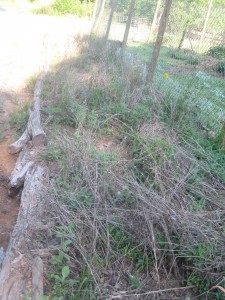
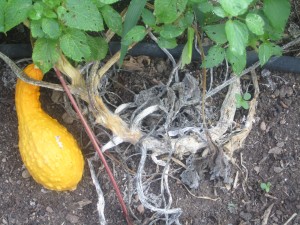
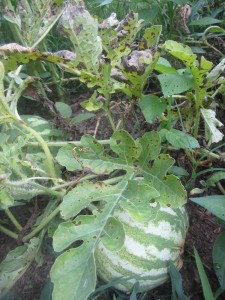
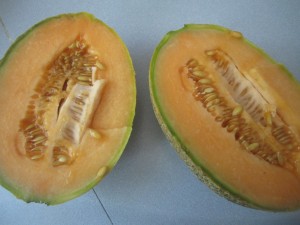
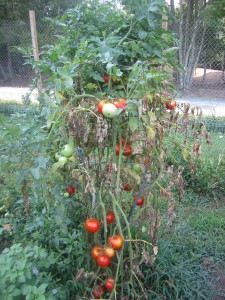
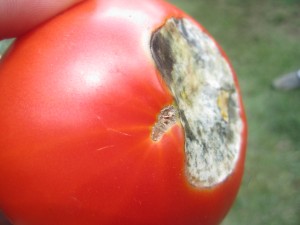
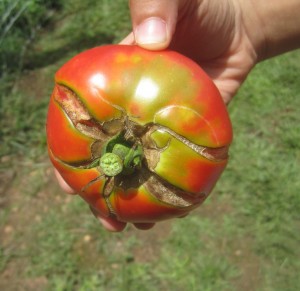


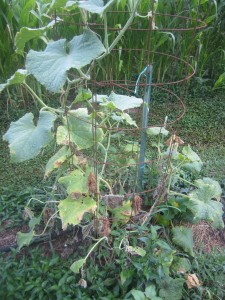
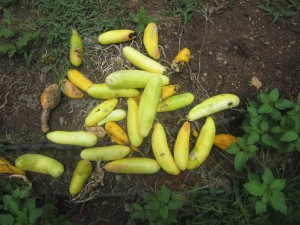
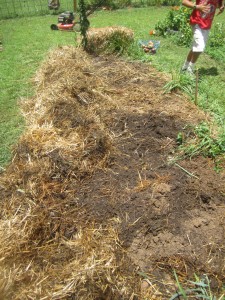

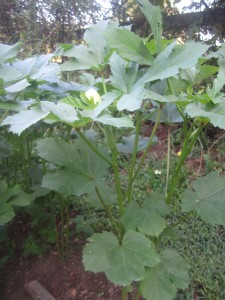
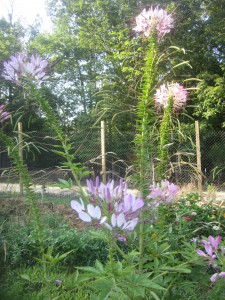
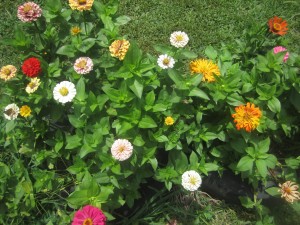
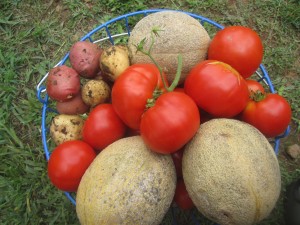
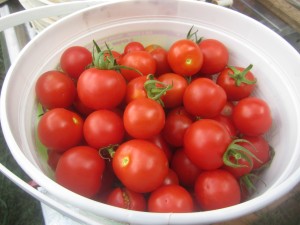



July 18th, 2012 @ 3:54 am
I just love reading your blog. I also just love having a garden, being able to go outside, picking something that you have grown and eating it…that’s the best.
Your canteloupes and tomatoes look good.